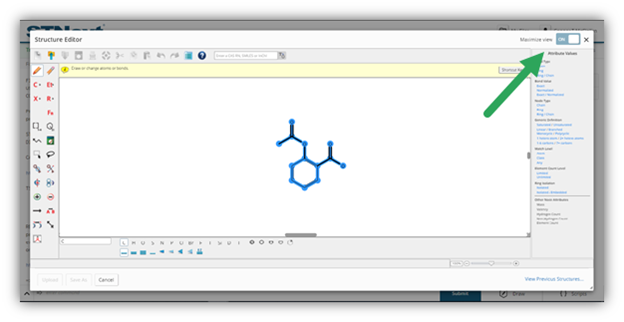
STNext users often found the default Structure Editor size too small, and they struggled to resize it. They also encountered the Structure Editor being too large, exceeding the boundaries of their browser window, which made for difficult resizing if the browser was zoomed.
Now, when the user opens the Structure Editor a Maximize View option is available and set to Off, which is the default mode when the editor is first opened. When the user clicks the Off toggle and it changes to On, the system will permanently remember the "On" preference for the Maximize View options for all subsequent sessions, as it will when switching the option from On to Off.
When Maximize View is switched On, the Structure Editor resizes to fill the largest possible area given the browser window, with 30-pixel margins on all sides. When the user attempts to manually resizes the Structure Editor with Maximized View switched On, the system toggles the setting to Off and allows the user to manually resize the editor.

When Maximize View is switched Off, the Structure Editor resizes to the minimum size (default size) and centers in the browser window. A grabber icon is visible to the user in the bottom-right corner of the Structure Editor; when the user clicks and drags the icon, they can manually resize the editor window. (existing functionality).
The Structure Editor is draggable within an area defined as the browser window minus 30-pixel margins on all sides, which is the same area as the Maximized View. When the user resizes the browser window to a size smaller than the minimum Structure Editor size, horizontal scroll bars are visible in the browser.
The Structure Editor is also still visible and pinned on the screen regardless of how small the user resizes the browser window.
The user now has a choice within the Structure Editor Preferences on a how carbon node renders on the drawing canvas: angle, dot, or the letter C.
The Structure Editor’s Attributes panel now includes an option for highlighting isolated rings. For a structure with isolated ring(s):
When the user uploads the structure, the structure information section in the session transcript contains the section Isolated Ring Nodes followed by the node numbers of the of the isolated ring(s).
When the user downloads the transcript, the structure information section in the downloaded transcript contains the section Isolated Ring Nodes followed by the node numbers of the of the isolated ring(s).
Before |
After |
 |
 |
Users may now download reports in .xml format. When the user selects the XML report format, and then clicks the Download button, the system generates and downloads a .zip file containing a .xml file with image extensions for the corresponding report content.
Note: If the report does not contain any images, the .xml file will still be downloaded as a zip file. The “Downloading file(s)” notification banner will be presented to the user.
If the user selects a custom template, .zip/.xml persists the name of the custom template:
Example: “MyCustomTemplate” template → MyCustomTemplate.zip
Example: “MyCustomTemplate” template → MyCustomTemplate.xml
If the user selects a standard template, the .zip/.xml file are assigned a system name in the following format: [YEARMONTHDAY][TEMPLATE]REPORT.zip / [YEARMONTHDAY][TEMPLATE]REPORT.xml
Example: 20210312PATENTREPORT.zip / 20210312PATENTREPORT.xml
See XPATH Examples for STNext XML Reports for more information.
In reports and .xls tables, using the HITSTR display command groups the associated IT, RN, CN, and STR fields together.
In report creation, when the user displays L-number(s) with the HITSTR command, selects the Standard/Enhanced/Table formats, and selects the Journal/Patent/Patent and Journal/Substance templates, the new Hit Structure > Index Terms with Structures field appears in the report/table and in the Included Fields column when customizing.
The generated:
Report displays the IT fields with associated STR, RN, CN fields as seen in classic display session and in transcripts.
Table has the associated IT, RN, CN, and STR fields together in one column.
Before |
After |
 |
 |